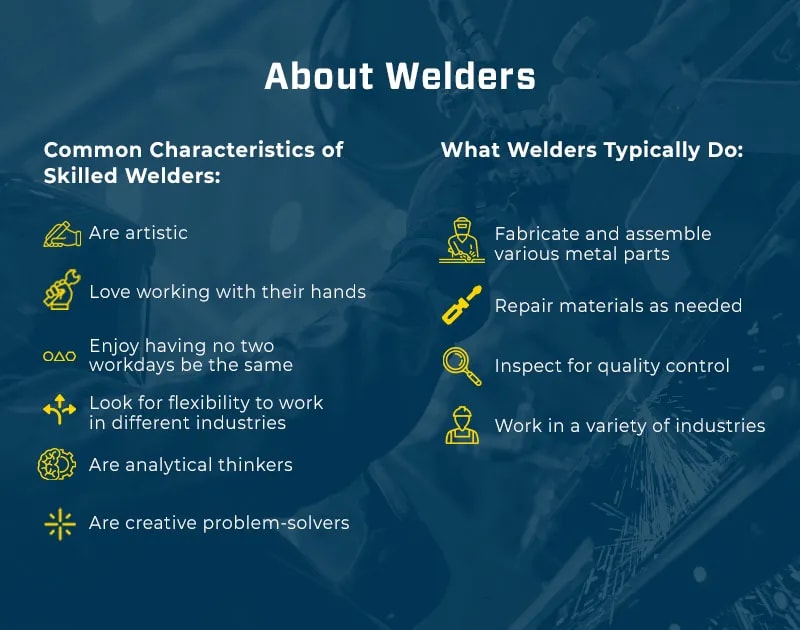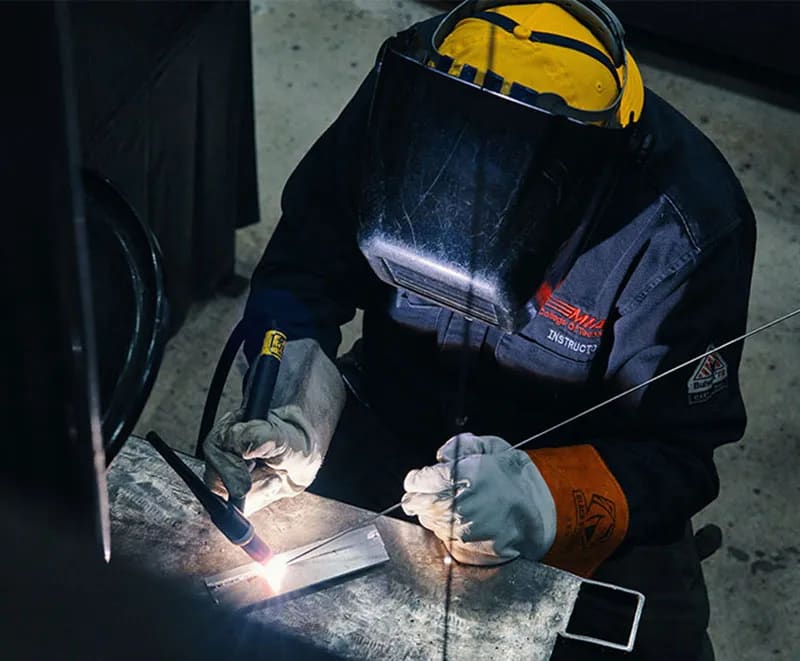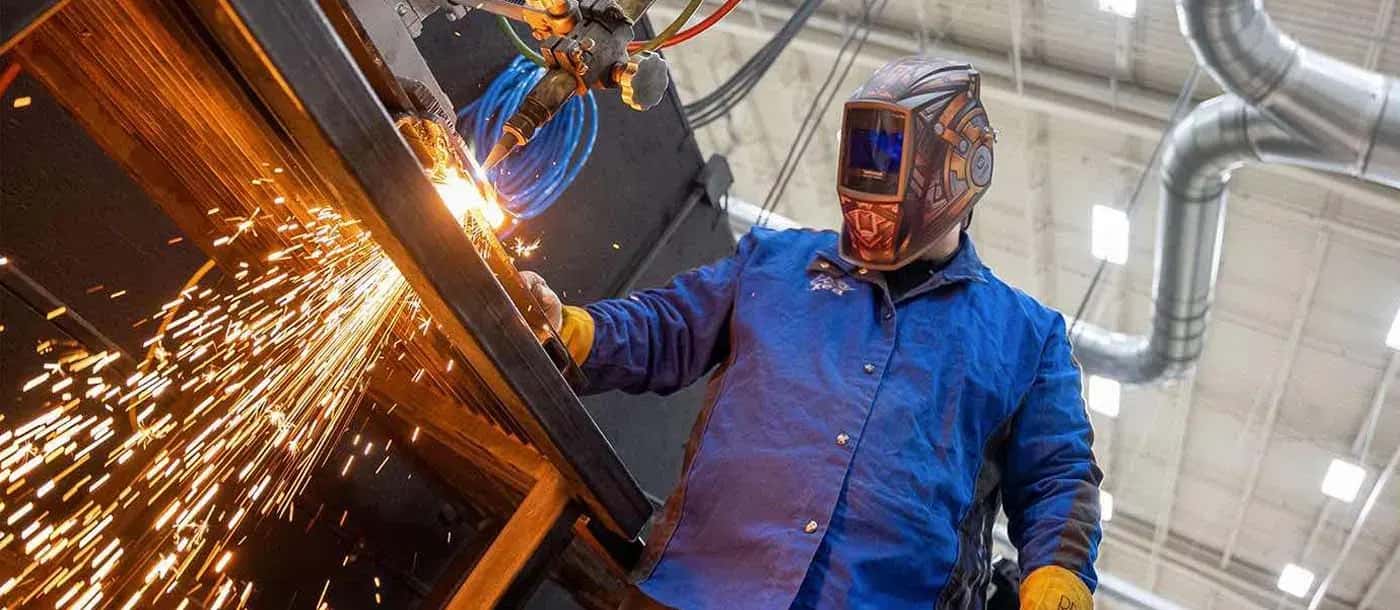MIAT CANTON WELDING PROGRAM OVERVIEW
When searching for welding trade schools, look no further than MIAT College of Technology in Canton, Michigan! Part of the Universal Technical (UTI) family of schools, MIAT Canton offers hands-on labs and a curriculum built using different fundamental welding principles used by the American Welding Society (AWS) and The National Center for Construction Education and Research (NCCER).
Here are some other reasons MIAT Canton’s Welding school can be a great option:
- Dedicated teams to help with financial aid,10 housing and employment1
- Learn a variety of welding processes (with a focus on gas tungsten arc welding, or GTAW)
- Flexible class options
WELDING TRAINING
What Makes Welding Training Different at MIAT Canton?
- Connections with employers1
- Complete the program in less than a year
- No prior experience needed
- Hands-on learning that mirrors real-world experience

WELDING TYPES TAUGHT
The MIAT Canton campus has a large focus on training with welding methods used in the aerospace and motorsports industries. There are four main types of arc welding taught at MIAT Canton:
Gas Tungsten Arc Welding (GTAW)
Students spend the majority of their time learning this process at the Canton campus. Also known as TIG welding, which stands for tungsten inert gas, GTAW uses inert gasses such as argon or helium as protective shielding agents. The TIG process uses a tungsten electrode with a high melting point that delivers the heat to the metals, melting the metals in the process.
Shielded Metal Arc Welding (SMAW) I
Another big focus for students in welding at our Canton campus is shielded metal arc welding (SMAW), also known as stick welding, which is a method that can be used in all positions. It utilizes a flux-coated electrode (metal stick in an electrode holder) connected to a power source to touch the base metal and produce a weld.
Gas Metal Arc Welding (GMAW)
GMAW is a method using a continuous solid wire electrode through the welding gun, accompanied by a shielding protective gas that prevents contamination. The process can be semi-automatic or fully automatic, making it a great choice for beginners. It can be used indoors for industries like construction, manufacturing, aerospace and vehicle production.
Flux-Cored Arc Welding (FCAW)
Flux-cored arc welding (FCAW) utilizes a continuous hollow wire electrode with a flux compound that protects the weld pool by forming a gas. FCAW is becoming popular in the general fabrication, shipbuilding and construction industries due to its higher deposition rates and efficiencies. It is also commonly used on carbon steel and stainless alloys.
WELDING COURSES IN CANTON, MI
Thanks to our hands-on labs and a curriculum that’s built with help from industry leaders, welding training at MIAT means training tailored to industry needs. Here are some of the welding courses offered at the Canton campus:
Shielded Metal Arc Welding I
Students learn how to clean and prepare all types of base metals for cutting or welding. They learn to identify and explain weld imperfections, the use of fit-up gauges and measuring devices, how to check for joint misalignment and welding safety.
Shielded Metal Arc Welding II, Drawings, Symbols and Metal Characteristics
This course describes the preparation and setup of arc welding equipment and the process of striking an arc. Students learn how to detect and correct arc blow and how to make stringer, weave, overlapping beads and fillet welds. Students will learn to complete quality welds using SMAW equipment.
Shielded Metal Arc Open Root Welding
Students learn how to complete a quality weld on materials using SMAW equipment. This course explains how to set up SMAW equipment for open-root V-groove welds; how to prepare for and make open-root V-groove welds on various fittings, flanges, structures and carbon steel pipe; and procedures for making open-root V-groove welds.
GMAW Welding
In this course, students complete a quality weld on pipe using GMAW equipment. Students learn the procedures and techniques used to make open-root V-groove welds with GMAW on various fittings, flanges, structures and pipes.
GTAW Aluminum Welding
This course explains how to set up GTAW equipment for aluminum welding processes and covers the procedures and techniques used to welds with GTAW in multiple positions with multiple forms of aluminum stock.
GTAW Carbon Steel Welding
This course explains how to set up GTAW and covers the procedures and techniques used to make V-groove pipe welds with GTAW. Students learn to complete quality welds with GTAW equipment.
GTAW Stainless Steel Welding
In this course, students learn how to weld on stainless steel using GTAW equipment. The course explains how to set up GTAW equipment and covers the procedures and techniques used to make V-groove pipe welds with GTAW.
GMAW/FCAW/GTAW, Equipment and Filler Metals
This course describes general safety procedures for GMAW and FCAW, identifies GMAW and FCAW equipment and explains the filler metals and shielding gases used to perform GMAW and FCAW. Students learn these different methods to perform quality welds.
WELDING CAREER OPPORTUNITIES IN CANTON, MI
Because MIAT Canton has a focus on GTAW, completing welding training with us can help students feel prepared to pursue entry-level careers, particularly in the aerospace and motorsports industries. Most of our grads start out working as entry-level technicians or in other entry-level roles. As with any industry, over time, you may be able to advance in your career with hard work.78
Some entry-level careers could include:
- Welder
- Fabrication welder
- Welder fitter
- Wirer
As you gain experience and skill, some more advanced careers in welding might include:
- Inspector
- Quality control
- Certified welding inspector
- Welding project manager
According to the Bureau of Labor Statistics (BLS), the median annual salary in the United States for welders, cutters, solderers and brazers was $51,000 in May 2024.26 This means that half earned more and half earned less. Keep in mind that salary depends on several factors, including experience, employer, demand and cost of living in the area.

ABOUT THE CAMPUS
The MIAT Canton campus is equipped with state-of-the-industry labs where students receive hands-on training to feel prepared to pursue a career in welding.
On campus, you can enjoy a community of students who share your passion and supportive instructors who offer experience and insight as you learn to weld.
See what makes MIAT Canton a great place to train by taking a campus tour.
WHAT SKILLS DO YOU NEED TO BE A WELDER?
WELDING TRAINING NEAR ME
Conveniently located near Detroit, the MIAT Canton campus is within driving distance of attractions like the Detroit Institute of Arts, the Henry Ford Museum of American Innovation and the Detroit Zoo. Combine that with supportive instructors and hands-on training that can be completed in just 9 months and Canton, Michigan, can be a great place to train for a welding career.

